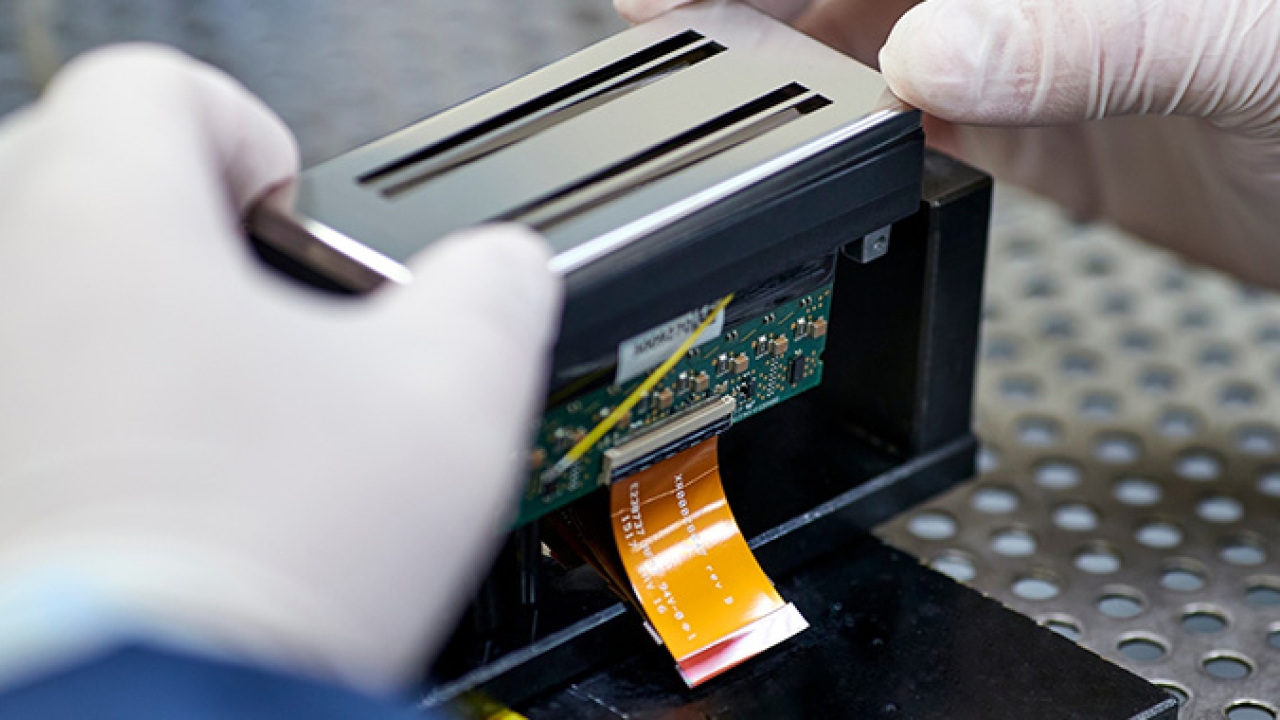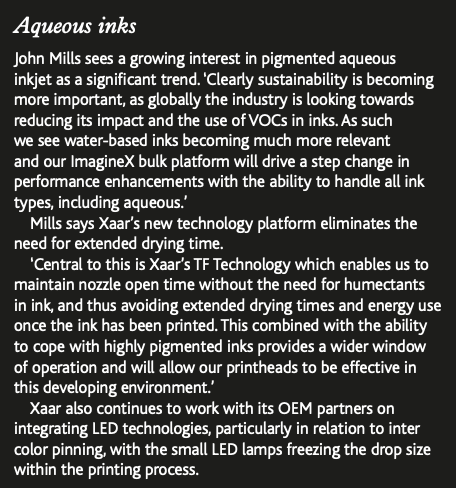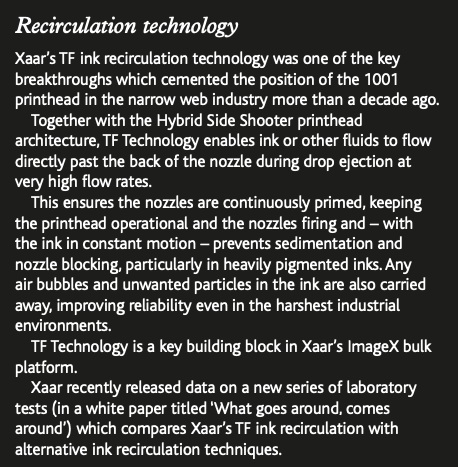Xaar looks to regain printhead leadership

 Since that high point Xaar has faced increasing competition from other inkjet head manufacturers in the narrow web sector, while a focus on the ceramic market took the company’s eye off developments in the label industry, as CEO John Mills accepts: ‘Our focus on the booming ceramics market meant Xaar drifted from the label industry for a little while.’
Since that high point Xaar has faced increasing competition from other inkjet head manufacturers in the narrow web sector, while a focus on the ceramic market took the company’s eye off developments in the label industry, as CEO John Mills accepts: ‘Our focus on the booming ceramics market meant Xaar drifted from the label industry for a little while.’
Now, having identified label and packaging printing once more as a key strategic market, Xaar aims to reclaim its place at the top table with the launch of a raft of new technologies.
Key to the relaunch is Xaar’s ImagineX bulk printhead technology, the culmination of a £70m (USD 89.8m) R&D investment program, initially focused on thin film but which now sets the roadmap for the next 30 years of product development.
The investment program behind ImagineX will drive a range of performance enhancements, pushing print resolutions up to 1,440 DPI and speeds of 150kHz, as well the capability to operate at temperatures over 200 deg C and viscosities above 100cP. The printheads will also be able to handle all ink types, including aqueous.
‘The ImagineX platform takes all the IP generated in the last 10 years and answers the question how do we take our existing products and move things forward,’ says Mills.
New printhead
The new 2002 printhead was developed as part of the ImagineX program and provides Xaar’s core technology for the narrow web label and package print market.
The 2002 head delivers 720 DPI print resolution and what Xaar describes as ‘plug and play’ integration. ‘Drop-in printhead alignment and mechanical tolerance improvements allow the printheads to be dropped into the printbar easier, enabling faster set-up times,’ explains Mills.
A combination of Xaar’s new Tuned Actuator Manufacturing (TAM2) and AcuChp technologies give the Xaar 2002 printhead improved color uniformity across the width of the printhead, while firing frequencies of up to 36kHz deliver speeds up to 75m/min at 720 DPI. The Xaar 2002 is fully backwards compatible with printers already using the Xaar 2001+.
The first press to use the new 2002 printheads is Canon’s LabelStream, now successfully printing at 75m/min.
Digital embellishment
While inkjet is an established printing technology, digital embellishment is an exciting future trend. This means replacing UV flexo or rotary screen printing of coatings such as varnishes and adhesives with a jettable fluid. ‘Xaar’s TF Technology and Ultra High Viscosity capability opens up a wide range of new inkjet applications with the ability to lay down a much wider range of fluids, offering advantages such as an increased color gamut, opacity and special effects,’ explains John Mills.
 Mills is particularly excited about the possibilities of inkjet high build coating. ‘High-build varnish embellishments can be made in a single pass to add texture, visual impact, and functionality to labels and packaging. From braille and tactile warning triangles required on packaging to the latest 3D effects that ensure real shelf presence and bring images to life, digital print can avoid the complexity of traditional screen printing, adding features quickly and costeffectively to traditional printed items.’
Mills is particularly excited about the possibilities of inkjet high build coating. ‘High-build varnish embellishments can be made in a single pass to add texture, visual impact, and functionality to labels and packaging. From braille and tactile warning triangles required on packaging to the latest 3D effects that ensure real shelf presence and bring images to life, digital print can avoid the complexity of traditional screen printing, adding features quickly and costeffectively to traditional printed items.’
Mills says the Xaar 2002 can achieve thicknesses of 130 micron at around half a meter per second or 80 micron at one meter per second. ‘By using two printheads in a print and cure array, it is therefore possible to build much taller features and enables features such as braille and warning triangles to be added to labels and packaging in a single pass.’
Another trend is the replacement of a first down UV flexo or UV screen white with inkjet.
‘Xaar’s printheads can easily handle highly pigmented inks which makes them ideal for many label applications,’ says Mills. ‘Xaar’s digital inkjet can match analogue with high opacity whites printed in one pass, which avoids the need for slow and complex screen printing.’
Mills points out that the Canon Océ Labelstream press was already achieving impressive high opacity whites using Xaar 2001+ printheads. ‘This enables it to deliver an impressive 80 percent opacity Alpine White at speeds of 48m/min in its Graphics mode, and a 67 percent opacity, or “true white”, in a faster Production mode at 68m/min. In future this will grow even further with Xaar’s new ImagineX bulk printhead platform.’
Mills sees these capabilities as offering great potential for the future development of hybrid flexo-digital presses. ‘The exceptional print capabilities and versatility of inkjet printheads are more and more providing customization capability and high-end features into existing flexo presses, usually through the addition of an extra printbar.
 ‘Digital printing adds an extra dimension to traditionally printed items, enabling brands to have the freedom to localize, personalize and customize their products. Individual messages, codes and further printed features can be included on flexo printed labels and packaging for extra appeal or the creation of online competitions, communicating and engaging with consumers as part of highly effective promotional campaigns.’
‘Digital printing adds an extra dimension to traditionally printed items, enabling brands to have the freedom to localize, personalize and customize their products. Individual messages, codes and further printed features can be included on flexo printed labels and packaging for extra appeal or the creation of online competitions, communicating and engaging with consumers as part of highly effective promotional campaigns.’
Future trends
Among the emerging applications for inkjet is direct to shape printing – L&L visited the first commercial installation of a Krones/ Xaar direct-to-glass decoration line at the Leuven ABInbev site printing beer bottles for niche marketing applications.
‘We see continued and growing interest in direct to shape printing,’ confirms John Mills. ‘The reliability and performance of the Xaar 1003 printhead proved instrumental in the ground-breaking, direct-to-bottle printing operation for the Becks beer campaign last year. At this stage we are unable to go into detail on new projects, however inkjet and the possibilities enabled is being explored by a growing number of OEMs and user developer integrators.’
Another future-oriented application for inkjet is printed electronics, and Xaar’s advanced manufacturing technology development team is very active in this area, Mills confirms.
‘As a development area it is difficult to go into specifics, however printed antennae and circuitry through to hidden covert security markings and technologies are all active projects. The ability of our printheads to cope with a wide variety of fluids through our High Laydown and Ultra-High Viscosity capabilities are making Xaar the partner of choice for many.’
Stay up to date
Subscribe to the free Label News newsletter and receive the latest content every week. We'll never share your email address.


